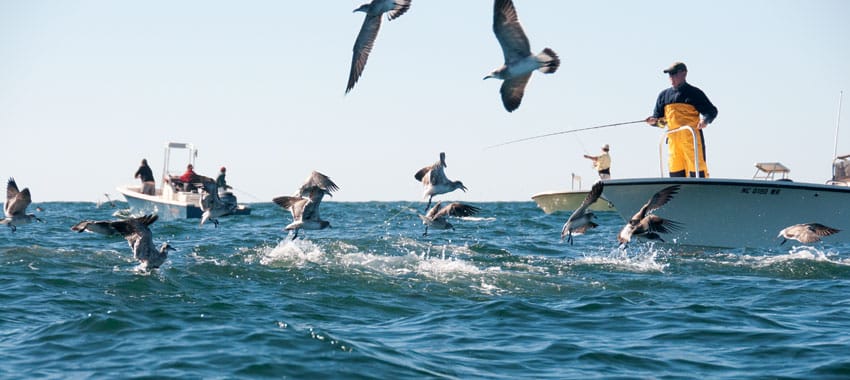
In all of angling, there’s nothing quite like sightfishing. Whether targeting a big, single permit on the flats, groups of surface-swimming cobia nearshore or tunas ravenously pounding bait on top in blue water, nothing stirs an angler’s soul more than spotting his quarry before delivering the cast. Sight-fishing is addictive, supremely challenging and uniquely rewarding. To many anglers, it represents the pinnacle, the ultimate form of sport fishing.
There are literally hundreds of outstanding sight-casting fisheries the world over. Many exist in coastal and inshore environments, created when clean, clear water pours in with the tide and floods flats, allowing anglers to stalk fish as a hunter stalks game.
Other sight-fisheries can be found in deeper-water arenas, where anglers cast to fish swimming and feeding just beneath — or, occasionally, just above — the water’s surface.
From New England to California to Florida, we hopscotch the U.S., chronicling a few of the country’s outstanding sight-fisheries.
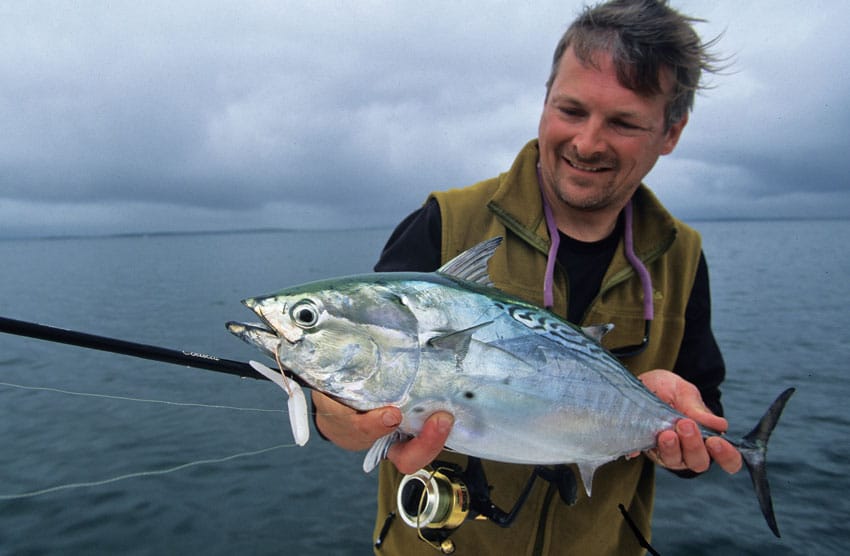
New England
New England: Albie Madness
Where sight-casting false albacore is a case of “Now you seem ’em…”
Will they show? That’s the main question when August rolls around, and rumors of false albacore (little tunny) start to percolate on the docks and online fishing forums from Cape Cod to Montauk.
While some years they never show, the short window for these Northeast scrappers is late August through mid-October, with September being square in the wheelhouse of prime time.
Albies typically follow on the heels of bonito and Spanish mackerel, both of which tend to clear out once the albies move in. For the first week or so following their arrival, the albies feed with abandon, allowing more shots at surface-feeding schools. Anglers who are ready to drop everything and get on the water quickly will reap the rewards.
Once the fish settle into an area, they usually become harder to catch, especially in calm, stable weather. Many times they break into smaller pods, coming to the surface to feed for just a few seconds before disappearing.
What makes the fish so selective is a matter of debate, or rather “de bait.” Last season along much of the coast, tiny bay anchovies (aka “rain bait”) and even anchovy larvae were the primary feed, and the albies were so keyed on this tiny prey that they rejected most standard lures, including metal spoons, flies and jigs.
But in general, I throw almost exclusively small, unweighted soft plastics at albies. My favorites are 4-inch Zoom Flukes, FinSFish, and SlugGos in pearl and pink.
The most effective way to fish these lures is to cast them into the middle of the feeding school, and twitch them gently across the surface so the tail wiggles and flips. You don’t need to rip the bait across the surface, but the retrieve speed should be somewhat faster than what you’d use for bass. — Tom Richardson
The Skinny
Location: New England
Prime Time: September
Tackle: A 7½-foot spinning rod with a limber tip, matched to a midsize reel with at least 200 yards of 10- to 12-pound mono. Use a wind-on leader system. My favorite setup is a Spider Hitch or Bimini in the main line, tied to three feet of 20-pound-test fluorocarbon with a Bristol (No-Name) knot.
Skippers:
Capt. Terry Nugent
Riptide Charters
www.riptidecharters.com
Capt. Jaime Boyle
Boylermaker Charters
www.boylermaker.com
Capt. Ryan Sanscoucie
Hush Fly Fishing
www.hushflyfishing.com
About the Author: Tom Richardson is the publisher and editor of BoatingLocal.com, a Northeast online boating and fishing magazine.
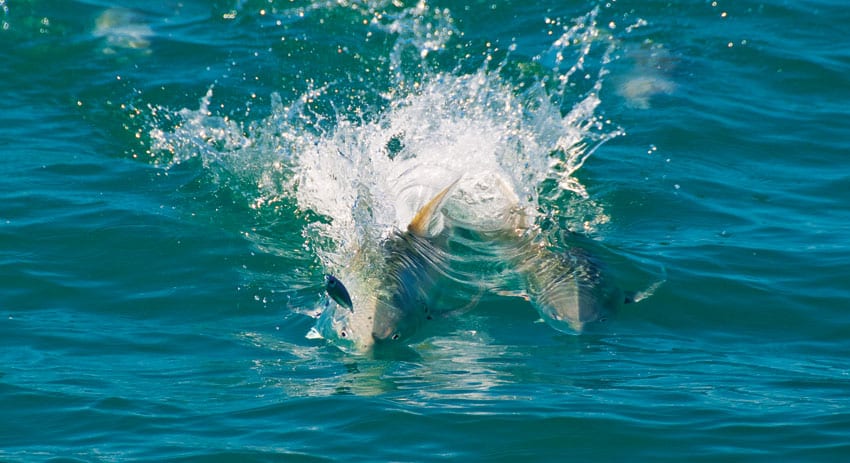
Stuart
Stuart: Jack Be Quick
Huge jack crevalle provide vicious topwater-plug action
Just about this time of year, anglers along Florida’s southeast coast are treated to one of the most outrageous fisheries the Sunshine State has to offer. To say it can be jaw-dropping is an understatement.
Hordes of jack crevalle — big ones — maraud just off the beaches from Palm Beach to Sebastian, clustering on the surface in schools that can include thousands of fish. Approach and present offerings to these bruisers correctly, and it’s very possible to latch onto the jack of a lifetime.
“It’s really something,” says Capt. Mike Holliday, of Stuart, Florida. “I’ve caught them to 42 pounds, and they can be incredibly aggressive.”
The action usually starts in late December, as huge schools of jacks in the 10- to 15-pound range begin to show. As spring approaches, the fishing only improves, with more-numerous pods of fish and much-larger specimens. Anglers generally run the beach at speed, watching closely for surface irregularities, brown-colored splotchy areas or (when conditions are calm) fins protruding from the surface, as the jacks slowly daisychain just beneath the chop.
“If I run 25 miles of beach in the spring, I’ll generally see eight or nine schools,” Holliday says. “One or two of those schools will be very small — but the fish will all be giants.”
Holliday says that’s a common thing — the largest fish tend to hold in the smallest schools and often fairly close to the beach, only a couple hundred yards out.
Early in the year, the jacks are not finicky. As spring and summer progress, however, they get skittish, and care must be taken to quietly intercept their movement with short bursts from a trolling motor.
Once in position, anglers cast big, noisy topwaters to the outer edges. The results can be, well, explosive — and because of this, the schooling jacks make a perfect fly-rod target. Bring a 12-weight and cast a popper into the fray, while another angler teases the monsters into a frenzy with a hookless plug.
Then it’s simply a matter of hanging on! — Mike Mazur
The Skinny
Location: Stuart, Florida
Prime Time: March through June
Tackle: Strong, yet castable spinning outfits with 20- to 30-pound braid and 3-foot, 60-pound leaders tied to large, heavy-duty topwater plugs, such as those made by Yo-Zuri and Halco
Skippers:
Capt. Mike Holliday
Stuart, Florida
www.mikeholliday.com
Capt. John Meskauskaus
Stuart, Florida
www.stuartflyfishing.com
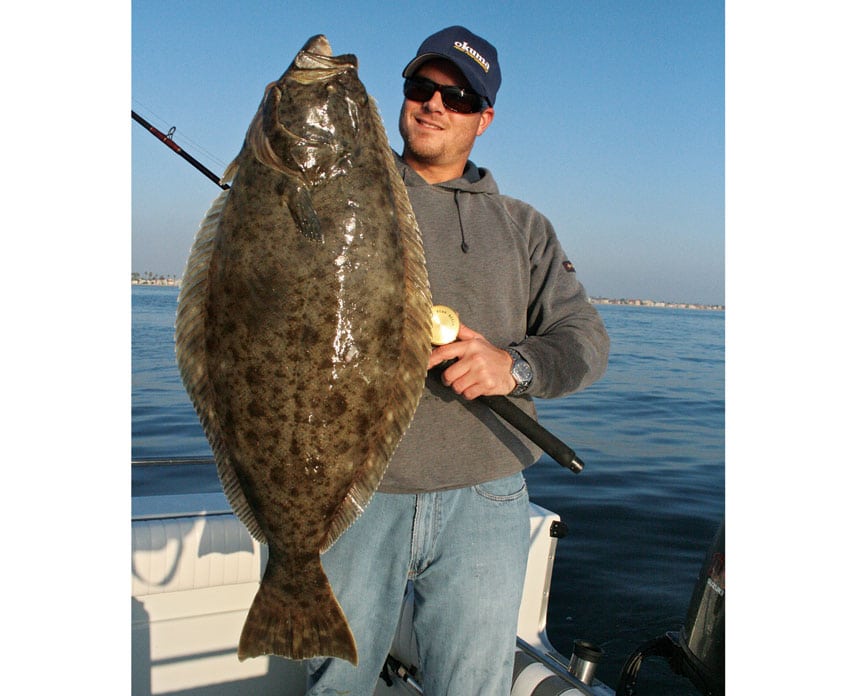
SoCal
SoCal: Eyeballing Flatties
Sight-fishing for halibut in the clear island waters off Southern California
When the water becomes gin-clear around Southern California’s offshore islands, sight-fishing for halibut can be surprisingly effective, according to Capt. Mark Wisch of Huntington Beach, California, who has detailed the technique in his book, In the Gray, a private-boaters guide to fishing island waters (pacificedgepress.com).
Spying California halibut even in clear water starts with looking in the right places. “The bulk of the halibut live on sand next to rocks or kelp,” Wisch explains. “If there is any discernible current, the fish tend to be on the up-current edge of the sand.”
Water depth needs to be 25 feet or less so you can see the bottom and any halibut, some of which can reach 30 pounds or more. It helps to let your eyes “go soft,” so you are absorbing more than staring, says Wisch. It also helps to perch in a flybridge or tuna tower, and wear polarized sunglasses to peer through the surface glare.
When scanning, all you might see is the faint irregular pattern of the sand. Even though partially buried in the sand and well camouflaged, a halibut’s oval shape can be discerned as it waits to ambush unwary prey.
Halibut also actively pursue forage. “If there are schools of bait, look under the bait for halibut shadowing them,” says Wisch.
Six-inch-long sardines or mackerel jack (known locally as Spanish mackerel) are among the best baits for halibut. Using 20-pound-test, the terminal setup starts with a 2-footlong surgeon’s loop, split so the ends are 18 and 30 inches. Tie a No. 2 treble hook to the short end, and a 6- to 8-ounce torpedo sinker to the long end. The heavier weight helps ensure the bait gets to the bottom quickly.
Because the bait can fold inside the halibut’s mouth, a treble hook results in fewer lost fish, as does hooking the bait with one of the trebles just under the skin on the back, even with the end of the gill covers, says Wisch.
The bait needs to be close to the fish to elicit a strike, though halibut will occasionally chase it a few feet. Once you see the fish inhale the bait, give it a slow count to five, wind down and set the hook. Then play big fish with a drag setting that allows the powerful flatfish an occasional burst of speed. — Jim Hendricks
The Skinny
Location: Islands off Southern California
Prime time: Spring, early summer and late fall
Tackle: Light conventional reel or saltwater bait caster with a matching 7-foot medium-light action rod
Skippers:
Capt. Mark Wisch
Huntington Beach, California
www.pacificedgetackle.com
Capt. Dave Hansen
Dana Point, California
www.yoursaltwaterguide.com
Editor’s Note: Before fishing any island shoreline, check for fishing closures that might be in place for 2012 as part of the California Marine Life Protection Act implementation plan for the South Coast region. For latest update, check back to sportfishingmag.com.
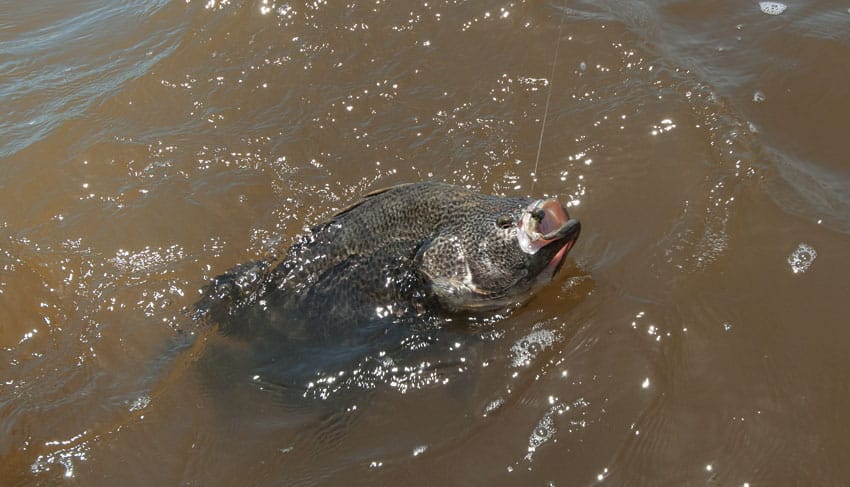
Georgia
South Georgia: Surface Surprise!
Double-digit shots at tripletail off the southern Georgia coast
When water temperatures warm to the mid60s each spring, a special type of fever afflicts my household. For lack of a formal diagnosis, let’s call it tripletail mania. Thankfully, this illness is confined to south coastal Georgia — or else it could spread with frightening consequences.
Tripletail flock to the shallow waters off Jekyll Island, Georgia, generally from April through July. But they don’t visit the usual haunts like crab pots, buoys or markers. They rise — at nonspecific times — and lie flat at the surface, where cautious anglers can see them and cast live baits.
Some days, anglers spot more than 60 fish — ranging in size from a pound or two to more than 20 — cast to half of those and catch perhaps half again. Capt. Greg Hildreth sight-fishes these tripletail each season, finding them close to the beach on high tide and as far as two to three miles out on the low.
His tackle: 7-foot All-Star ASR redfish or Penn Legion rods with Penn Battle 2000 reels, 20-pound SpiderWire Invisibraid and 25-pound Stren fluorocarbon leader in the tannic color. He rigs a live shrimp on a Mustad No. 4 Kahle hook about 15 inches below a Pradco Paradise Popper float. Anglers are maneuvered to intercept swimming fish, and cast ahead and past the school, gently reeling the bait to the fish.
Georgia anglers may keep two tripletail a day that measure more than 18 inches. But Hildreth and others frequently tag and release fish for the state’s Coastal Resources Division. Conventional- and sonic-tagging studies have found that Georgia’s spring and summer tripletail winter in Florida, as far south as Jupiter Inlet. One fish, caught and sonic-tagged near Savannah in 2010, also returned to the same estuary the following year.
A two-year study focusing specifically on the Jekyll tripletail revealed that those fish are not actively spawning while off the beach. However, many showed signs that they might be in a prespawn or temporary-staging phase.
The research has not yet provided Georgia with abundant data, though Hildreth and others say they’ve seen fewer tripletail during the past two seasons. Cold winters might have affected the species throughout its range. Still other anglers theorize the fish just might be catching on — not what tripletail maniacs want to hear, especially when the fever strikes. — Chris Woodward
The Skinny
Location: Jekyll Island, Georgia
Prime Time: May and June
Tackle: 7-foot medium-heavy spinning rods, reels spooled with 20-pound braid, 25-pound leader, popping corks/floats, Kahle hooks and live shrimp, D.O.A.s or Gulp! shrimp
Skippers:
Capt. Greg Hildreth
St. Simons Island, Georgia
912-261-1763
www.georgiacharterfishing.com
Capt. Jay Childers
St. Simons Island, Georgia
912-230-2473
www.jaybirdfishingcharters.com
Capt. Mike Duckworth
St. Simons Island, Georgia
912-506-9429
www.goldenislesflyfishing.com
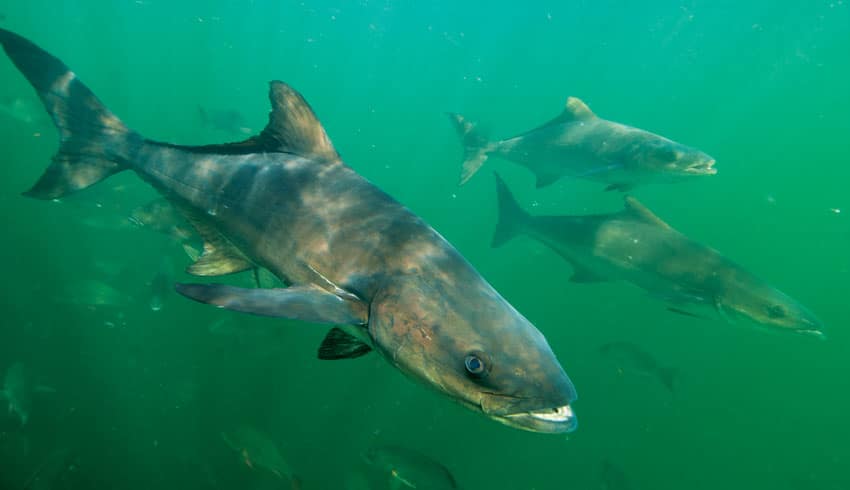
Destin
Destin, Florida’s Cobia Capital
Pitch baits to big cobia cruising the emerald waters off Panhandle beaches
Around the middle of March, the invasion begins. Florida’s Panhandle has by then geared up to meet the onslaught, and for the next couple of months, an armada of boats large and small — all sporting towers from the high and elaborate to the low and makeshift — will be patrolling off the beaches from dawn till dusk.
It’s cobia season.
While cobes can show here as late as June, the real concentrations occur in the spring, when the clear green waters off the Panhandle become to a sight-fisherman what the Magic Kingdom is to a 4-yearold. It’s hard to find a more exciting time in any fishery anywhere than when big cobia — singles, pairs and groups — cruise the surface off Destin and Florida’s Panhandle.
“Big” is a relative term, notes Capt. Pat Dineen (flyliner.com), for many years a fixture as a top inshore and nearshore guide for these waters.
As a testament to how large cobia might run here, Dineen says locals have been disappointed that tournament-winning fish in the past few years haven’t topped the century mark (though some have been only a few pounds shy of that). “But it still takes fish in the high 70s or 80-plus to get the ‘good-job nod’ from locals,” he says.
Spotting those fish is the name of the game. Wind can be a factor — the direction at least as much as the velocity. “Best is a brisk southeast wind with good sun. Anything from southeast to south is usually pretty attractive,” Dineen says. Surprisingly, days when the water isn’t a clear emerald green but has some turbidity might produce very well. “Cobia at the surface will contrast nicely when the water’s a bit unclear,” Dineen says. “They often show up lighter against dirtier water.”
“The higher you are off the water, the better,” Dineen says. But there are limits: Some towers on large boats nudge the stratosphere a bit too much. “In my opinion, the best boat is a 30- to 40-footer with a marlin tower right above the hardtop.” On the other hand, he says: “I have a 22 Pathfinder with T-top tower and controls. I might not see as many fish as the big boys, but I catch most of what I see.”
Catching those fish can mean putting anything in the water at times or, when they’re finicky, darn near everything. Most cobia veterans carry a smorgasbord of baits in the livewell — eels, mullet, pinfish and more. If a picky cobia won’t go for one, it might clobber the next. — Doug Olander
The Skinny
Location: Destin and Florida’s Panhandle
Prime Time: March through May and into June
Tackle: 25- to 30-pound braid on a 7-foot spinning rod with plenty of backbone
Skippers:
Capt. Don Dineen
Sure Lure Charters, Destin
www.surelurecharters.com
Capt. Jason Hallmark
Mother Lode, Destin
www.charterboatmotherlode.info
Capt. Jeff Moorman
First Light, Panama City
www.firstlightfishingcharters.com








